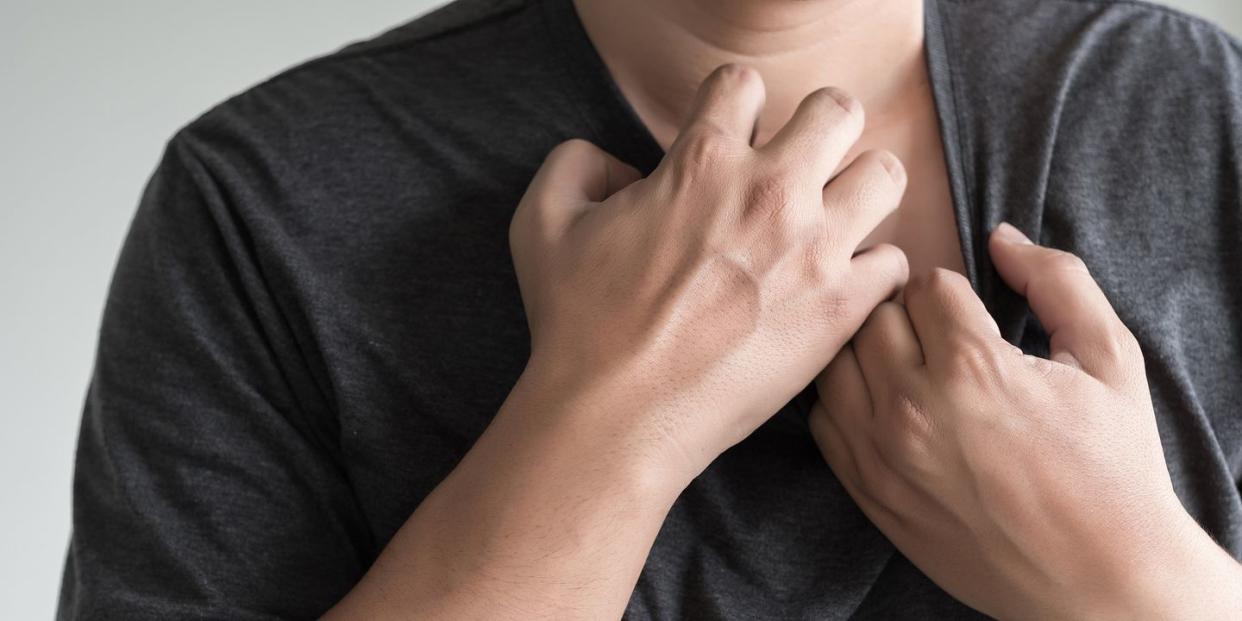3 Signs Your ‘Bad Skin’ Is Actually Something More Serious

Your skin doesn’t lie. And that’s mostly because it can’t. As your body’s largest organ, one of its primary jobs is to find a way to bring any potential issues to your attention. “The skin is often a mirror of what’s going on in the body,” says Adam Friedman, MD, professor and Interim Chair of Dermatology at The George Washington University School of Medicine & Health Sciences.
That’s not to say the epidermis is straightforward or forthcoming. What may appear to be just a bump, only a zit, nothing but a harmless rash or razor burn may in fact be something serious. To reach the correct diagnosis, Dr. Friedman adds, one must be “a good historian.” he adds. “Much of medicine is based on the story: When did it start? How long did it last? Where does it occur? What has helped or hurt the condition? Anyone else in the family get this?”
To help you be the best historian you can, here are three clues you might have a more serious skin condition and not just a little itch.
You have a painful rash.
Lots of things can cause a rash. In fact, what’s known as “contact dermatitis” is a dry, scaly rash caused by direct contact with something benign (like hand sanitizer, disinfectant, soap, laundry detergent) or a red, itchy rash caused by contact with something you’re allergic to (like nickel, latex, or fragrance). Although contact dermatitis is no day at the beach, it can often easily be treated with over-the-counter topicals or antihistamines.
If, however, you have a rash that’s painful, begins to blister, is accompanied by fever, or develops out of nowhere and spreads rapidly, you should see your doctor. All of the above are signs of something more serious, such as an infection, allergic reaction, or bad reaction to medication. If breathing becomes difficult, call 911 right away. And “if a skin ailment cannot be managed with DIY (remedies) or has failed management by an urgent care or a primary care doctor, see a dermatologist,” says Dr. Friedman.
You have acne in weird places.
Everybody experiences the occasional breakout, but the distribution of bumps is a tipoff that what you’ve got isn’t standard-issue acne. Location is key. Tender, red bumps on the shins, for instance, could be erythema nodosum (an inflammatory condition); on the hands, painful bumps may be a sign of chilblains (inflammation of small blood vessels); and pimples or boils in the armpits or groin may be a sign of a condition called hidradenitis suppurativa (HS), says Steven Daveluy, MD, associate professor and program director in the Department of Dermatology at Wayne State University.
“Acne and HS are associated diseases, meaning many patients with one will have the other.” How can you tell one from the other? “Acne on the body is often called ‘acne folliculitis,’ ” says Dr. Daveluy. “Folliculitis has small pimples that can be red or pus-filled bumps. In HS, patients can get the same pimples, but they also get larger, deeper boils and nodules. If you’re getting larger bumps in those areas, it’s time to see a board-certified dermatologist.”
Other clues it’s time to see a derm: The acne isn’t responding to treatment or there’s joint pain that happens with your breakouts.
Your skin never quite completely heals.
“Some things tend to have symptoms and lesions that come and go or flare up and then calm down,” says Dr. Daveluy. If that’s the case, “a physical exam is crucial.”
For instance, a red, swollen, pus-filled boil could be a skin infection known as a bacterial abscess, which is usually a one-time problem, says Dr. Daveluy. Or it could be the far more serious HS. How to know? With HS, breakouts that look like pimples or boils clear for a while, only to return in the same area, if not the exact same spot. In time, these lumps can break open and leak a foul-smelling liquid.
“If you’ve had more than one abscess, it’s time to consider HS,” says Dr. Daveluy. “One of the clues for HS that doctors sometimes miss is the scars from previous flares.” Because HS is often mistaken for another condition, people can go years without getting the care they need. Some live with HS for 12 years or longer before getting diagnosed, according to the American Academy of Dermatology.
You Might Also Like

